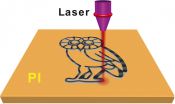Nuclear medicine treatment shows promise for cancer therapy
New study shows promise for targeted therapy with radiopharmaceuticals
2014-12-10
(Press-News.org) Reston, Va. (December 9, 2014) - Cancer therapy can be much more effective using a new way to customize nuclear medicine treatment, researchers say in the December 2014 issue of The Journal of Nuclear Medicine. The process could also be useful for other diseases that could benefit from targeted radiation.
Targeted therapy with radiopharmaceuticals--radioactive compounds used in nuclear medicine for diagnosis or treatment--has great potential for the treatment of cancer, especially for cancer cells that have migrated from primary tumors to lymph nodes and secondary organs such as bone marrow. These disseminated tumor cells can be difficult to treat with a single targeting agent because there are dramatic differences in the number of targetable receptors on each cell.
In the study, breast cancer cells were treated with different concentrations of a cocktail of four fluorochrome-conjugated monoclonal antibodies. The amount of each antibody bound to each cell was determined using flow cytometry. Formulas were developed to "arm" the antibodies with the desired radionuclide and activity, calculate the absorbed dose to each cell, and perform a simulation of the surviving fraction of cells after exposure to cocktails of different antibody combinations. Simulations were performed for three alpha-particle emitters.
"Our approach moves radiation treatment planning for cancer therapy from the tumor level to the molecular and cellular level, with nuclear medicine serving as the treatment engine," stated Roger Howell, Ph.D., lead researcher. "The concepts are not restricted to cancer therapy but can be applied more widely to other diseases that may benefit from a targeted approach with cocktails of radiopharmaceuticals. The approach can also be extended to cocktails consisting of radiopharmaceuticals and non-radioactive agents."
The effect of the radiopharmaceutical cocktails was compared to that of single antibodies. In certain activities, cocktails outperformed single antibodies by a factor of up to 244. These findings suggest that targeted alpha therapy can be improved with customized radiolabeled antibody cocktails. Depending on the antibody combination and specific activity of the radiolabeled antibodies, cocktails can provide a substantial advantage in tumor cell killing. The methodology used in this analysis provides a foundation for pretreatment prediction of tumor cell survival in the context of personalized cancer therapy.
"This method is preferable, as it accounts for behavior of the drugs in the patient's body," Howell continues. "The beauty of either approach for planning a treatment is that the patient is not subjected to any radiopharmaceutical injections during the planning phase, which uses only fluorescent-labeled drugs. The patient is not injected with radiopharmaceuticals until the treatment phase, whereupon only a cocktail specifically optimized for that individual is administered. This spares the patient from receiving ineffective cocktails that may damage normal tissues and prevent further treatment."
INFORMATION:
Authors of the article "The Advantage of Antibody Cocktails for Targeted Alpha Therapy Depends on Specific Activity" include Jordan B. Pasternack, Jason D. Domogauer, Alisha Khullar, and Roger W. Howell, New Jersey Medical School Cancer Center, Rutgers, State University of New Jersey, Newark, NJ; and John M. Akudugu, Stellensbosch University, Tygerberg, South Africa.
Please visit the SNMMI Media Center to view the PDF of the study, including images, and more information about molecular imaging and personalized medicine. To schedule an interview with the researchers, please contact Kimberly Brown at (703) 652-6773 or kbrown@snmmi.org. Current and past issues of The Journal of Nuclear Medicine can be found online at http://jnm.snmjournals.org.
About the Society of Nuclear Medicine and Molecular Imaging
The Society of Nuclear Medicine and Molecular Imaging (SNMMI) is an international scientific and medical organization dedicated to raising public awareness about nuclear medicine and molecular imaging, a vital element of today's medical practice that adds an additional dimension to diagnosis, changing the way common and devastating diseases are understood and treated and helping provide patients with the best health care possible.
SNMMI's more than 18,000 members set the standard for molecular imaging and nuclear medicine practice by creating guidelines, sharing information through journals and meetings and leading advocacy on key issues that affect molecular imaging and therapy research and practice. For more information, visit http://www.snmmi.org.
ELSE PRESS RELEASES FROM THIS DATE:
2014-12-10
London, United Kingdom, December 9, 2014 - As the Ebola Virus Diseases (EVD) epidemic continues to rage in West Africa, infectious diseases experts call attention to the striking lack of treatment guidelines. With over 16,000 total cases and more than 500 new infections reported per week, and probable underreporting of both cases and fatalities, the medical community still does not have specific approved treatment in place for Ebola, according to an editorial published in the International Journal of Infectious Diseases.
Not only are treatment guidelines lacking, but ...
2014-12-10
Studying the social interaction of bears through the use of camera traps and visual observations requires that humans be able to tell individuals apart. A study done using volunteers to study the vulnerable Andean bear indicates that people can learn to identify individual bears, given a little practice. The research, done by San Diego Zoo conservationists with international collaborators using photos spanning many years, also indicates that young bears usually retain many of their unique markings as they grow older.
"Knowing, scientifically, that people who have been ...
2014-12-10
Researchers from Johannes Gutenberg University Mainz (JGU) and the Julius Maximilian University of Würzburg are proposing potential new active substances for treating the dengue virus. Just like Ebola, dengue fever is also caused by a virus for which there is currently no cure and no vaccine and can be fatal.
In the quest for medication to treat the dengue virus, the scientific community is focusing on a particular enzyme of the pathogen, the protease known as NS2B/NS3. The reason for this is that inhibitors of similar proteases have been revealed to be very effective ...
2014-12-10
JACKSONVILLE, Fla. -- A marker of immune function that predicts for better outcomes in patients treated with chemotherapy for triple negative breast cancer is also linked to improved prognosis in patients treated with chemotherapy for HER2-positive breast cancer. But that marker -- the quantity of tumor-infiltrating lymphocytes (S-TILs) in a biopsy -- appears irrelevant when trastuzumab is used.
And since trastuzumab, and not chemotherapy alone, is the standard of care for the HER2-positive sub-class of breast cancer, there is no need to test for these lymphocytes in ...
2014-12-10
In patients with metastatic triple-negative breast cancer--a disease with no approved targeted therapies--infusion of pembrolizumab produced durable responses in almost one out of five patients enrolled in a phase-Ib clinical trial, according to data presented Dec. 10, at the 2014 San Antonio Breast Cancer Symposium.
The multi-center, non-randomized trial was designed to evaluate the safety, tolerability and antitumor activity of bi-weekly infusions of pembrolizumab (MK-3475, marketed as Keytruda®). The researchers enrolled 27 patients, aged 29 to 72 years, who had ...
2014-12-10
Several past studies have suggested that the magnetic fields created by phones, high-voltage power lines and other electrical equipment are harmful for humans.
Research first carried out in the 1970's and again subsequently, found an association between people living near overhead power lines and an increased risk of childhood leukaemia. Although some later studies have failed to find such a link, the International Agency for Research on Cancer has categorised low frequency magnetic fields as "possibly carcinogenic."
But a mechanism for this association has never been ...
2014-12-10
While many different combinations of genetic traits can cause autism, brains affected by autism share a pattern of ramped-up immune responses, an analysis of data from autopsied human brains reveals. The study, a collaborative effort between Johns Hopkins and the University of Alabama at Birmingham, included data from 72 autism and control brains. It will be published online Dec. 10 in the journal Nature Communications.
"There are many different ways of getting autism, but we found that they all have the same downstream effect," says Dan Arking, Ph.D. , an associate professor ...
2014-12-10
HOUSTON - (Dec. 10, 2014) - Researchers at Rice University have created flexible, patterned sheets of multilayer graphene from a cheap polymer by burning it with a computer-controlled laser. The process works in air at room temperature and eliminates the need for hot furnaces and controlled environments, and it makes graphene that may be suitable for electronics or energy storage.
Under a microscope, what the researchers call laser-induced graphene (LIG) doesn't look like a perfect chicken wire-like grid of atoms. Instead, it's a jumble of interconnected graphene flakes ...
2014-12-10
Phoenix, AZ (December 10th, 2014) - The brain responds differently to two kinds of sugar, according to a report today at the American College of Neuropsychopharmacology annual meeting in Phoenix Arizona. The study suggests that fructose heightens the response of brain reward circuits to food cues, promoting feeding behavior.
Currently, roughly two out of three U.S. adults are overweight and one out of three is obese. Changes in lifestyle and dietary intake during the past quarter century are thought to be the main culprits, with the increase in fructose consumption of ...
2014-12-10
PISCATAWAY, NJ - Communities with fewer places to buy or drink alcohol also tend to have lower rates of intimate partner violence, new evidence suggests.
The research, published in the January issue of the Journal of Studies on Alcohol and Drugs, suggests that laws limiting what is called "alcohol outlet density" could offer one way to address violence within intimate relationships.
States and communities throughout the United States have enacted various laws to reduce excessive use of alcohol, including limiting outlet density, limiting hours and days of sale, and ...
LAST 30 PRESS RELEASES:
[Press-News.org] Nuclear medicine treatment shows promise for cancer therapy
New study shows promise for targeted therapy with radiopharmaceuticals

